Panic Buying and Consumption Displacement during COVID-19: Evidence from New Zealand
Abstract
1. Introduction
1.1. Panic Buying as a Consumer Response
1.2. Panic Buying and Consumption Displacement during COVID-19
2. Data and Findings
2.1. Overall Retail Spending Patterns
2.2. Transactions
3. Discussion
- The panic buying event is catalyzed by an unexpected and suddenly occurring crisis phenomenon that triggers a policy response (e.g., a partial or complete lockdown) which may impact on people’s livelihood and their potential inability to provide for themselves in light of a prolonged crisis scenario.
- Once a panic buying scenario is initiated, overall spending increases sharply in the lead up to anticipated lockdowns.
- Transactional spending increases and subsides only slowly to a level higher than pre lockdown.
- Different consumption categories exhibit vastly different patterns. Consumption displacement occurs as increased spending flows from non-essentials to necessities of life. This is exacerbated by hoarding of essential items and government mandated shutdowns of some non-essential retail sectors.
- The magnitude of the panic buying event far exceeds historical seasonal patterns of consumer spending (outside of Christmas and Easter).
4. Conclusions
Author Contributions
Funding
Data Availability Statement
Conflicts of Interest
References
- Arafat, S. M. Yasir, Sujita Kumar Kar, Marthoenis Marthoenis, Pawan Sharma, Ehsanul Hoque Apu, and Russell Kabir. 2020a. Psychological underpinning of panic buying during pandemic (COVID-19). Psychiatry Research 289: 113061. [Google Scholar] [CrossRef]
- Arafat, S. M. Yasir, Sujita Kumar Kar, Vikas Menon, Charanya Kaliamoorthy, Srijeeta Mukherjee, Angi Alradie-Mohamed, Pawan Sharma, Marthoenis Marthoenis, and Russell Kabir. 2020b. Panic buying: An insight from the content analysis of media reports during COVID-19 pandemic. Neurology, Psychiatry and Brain Research 37: 100–3. [Google Scholar] [CrossRef] [PubMed]
- Ballantine, Paul W., Shazia Zafar, and Andrew G. Parsons. 2014. Changes in retail shopping behaviour in the aftermath of an earthquake. The International Review of Retail, Distribution and Consumer Research 24: 1–13. [Google Scholar] [CrossRef]
- Benker, Beth. 2021. Stockpiling as resilience: Defending and contextualising extra food procurement during lockdown. Appetite 156: 104981. [Google Scholar] [CrossRef]
- Bonneux, Luc, and Wim Van Damme. 2006. An iatrogenic pandemic of panic. BMJ 332: 786–88. [Google Scholar] [CrossRef] [PubMed]
- Brandtner, Patrick, Farzaneh Darbanian, Taha Falatouri, and Chibuzor Udokwu. 2021. Impact of COVID-19 on the customer end of retail supply chains: A big data analysis of consumer satisfaction. Sustainability 13: 1464. [Google Scholar] [CrossRef]
- Bristow, Gillian. 2010. Resilient regions: Re-‘place’ing regional competitiveness. Cambridge Journal of Regions, Economy and Society 3: 153–67. [Google Scholar] [CrossRef]
- Cato, Susumu, Takashi Iida, Kenji Ishida, Asei Ito, Hiroto Katsumata, Kenneth Mori McElwain, and Masahiro Shoji. 2021. The bright and dark sides of social media usage during the COVID-19 pandemic: Survey evidence from Japan. International Journal of Disaster Risk Reduction 54: 102034. [Google Scholar] [CrossRef]
- Chronopoulos, Dimitris K., Marcel Lukas, and John O. S. Wilson. 2020. Consumer spending responses to the Covid-19 pandemic: An assessment of Great Britain. Covid Economics 34: 145–86. [Google Scholar] [CrossRef]
- Chu, Charlene K. 2018. Psychological ownership in hoarding. In Psychological Ownership and Consumer Behavior. Edited by Joann Peck and Suzanne B. Shu. Cham: Springer, pp. 135–44. [Google Scholar]
- Clee, Mona A., and Robert A. Wicklund. 1980. Consumer behavior and psychological reactance. Journal of Consumer Research 6: 389–405. [Google Scholar] [CrossRef]
- Coles, Eve, and Philip Buckle. 2004. Developing community resilience as a foundation for effective disaster recovery. Australian Journal of Emergency Management 19: 6–15. [Google Scholar]
- Dholakia. 2020. Why Are We Panic Buying during the Coronavirus Pandemic. Available online: https://www.psychologytoday.com/blog/the-science-behindbehavior/202003/why-are-we-panic-buying-during-the-coronavirus-pandemic (accessed on 1 March 2021).
- Dubey, Souvik, Payel Biswas, Ritwik Ghosh, Subhankar Chatterjee, Mahua Jana Dubey, Subham Chatterjee, Durjoy Lahiri, and Carl J. Lavie. 2020. Psychosocial impact of COVID-19. Diabetes & Metabolic Syndrome: Clinical Research & Reviews 14: 779–88. [Google Scholar] [CrossRef]
- Garbe, Lisa, Richard Rau, and Theo Toppe. 2020. Influence of perceived threat of Covid-19 and HEXACO personality traits on toilet paper stockpiling. PLoS ONE 15: e0234232. [Google Scholar] [CrossRef] [PubMed]
- Gerritsen, Sarah, Victoria Egli, Rajshri Roy, Jill Haszard, Charlotte De Backer, Lauranna Teunissen, Isabelle Cuykx, Paulien Decorte, Sara Pabian Pabian, Kathleen Van Royen, and et al. 2020. Seven weeks of home-cooked meals: Changes to New Zealanders’ grocery shopping, cooking and eating during the COVID-19 lockdown. Journal of the Royal Society of New Zealand 17: 1–9. [Google Scholar] [CrossRef]
- Government of New Zealand. 2020. New Zealand COVID-19 Alert Levels Summary. Available online: https://covid19.govt.nz/assets/resources/tables/COVID-19-alert-levels-summary.pdf (accessed on 1 March 2021).
- Hall, C. Michael, Sanna Malinen, Rob Vosslamber, and Russell Wordsworth, eds. 2016. Business and Post-Disaster Management: Business, Organisational and Consumer Resilience and the Christchurch Earthquakes. Abingdon: Routledge. [Google Scholar]
- Hall, Michael C., Girish Prayag, Peter Fieger, and David Dyason. 2020. Beyond panic buying: Consumption displacement and COVID-19. Journal of Service Management 32: 113–28. [Google Scholar] [CrossRef]
- Herjanto, Halimin, Muslim Amin, and Elizabeth F. Purington. 2021. Panic buying: The effect of thinking style and situational ambiguity. Journal of Retailing and Consumer Services 60: 102455. [Google Scholar] [CrossRef]
- Hobbs, Jill E. 2020. Food supply chains during the COVID-19 pandemic. Canadian Journal of Agricultural Economics/Revue canadienne d’agroeconomie 68: 171–76. [Google Scholar] [CrossRef]
- Hunt, Elle. 2021. Words matter: How New Zealand’s clear messaging helped beat Covid. The Guardian. February 26. Available online: https://www.theguardian.com/world/2021/feb/26/words-matter-how-new-zealands-clear-messaging-helped-beat-covid (accessed on 1 March 2021).
- Islam, Tahir, Abdul Hameed Pitafi, Vikas Arya, Ying Wang, Naeem Akhtar, Shujaat Mubarik, and Liang Xiaobei. 2021. Panic buying in the COVID-19 pandemic: A multi-country examination. Journal of Retailing and Consumer Services 59: 102357. [Google Scholar] [CrossRef]
- Karatzias, Thanos, Sally Jowett, Elsie Yan, Robert Raeside, and Ruth Howard. 2017. Depression and resilience mediate the relationship between traumatic life events and ill physical health: Results from a population study. Psychology, Health & Medicine 22: 1021–31. [Google Scholar] [CrossRef]
- Kemp, Elyria, My Myla Bui, and McDowell Porter, III. 2021. Preparing for a crisis: Examining the influence of fear and anxiety on consumption and compliance. Journal of Consumer Marketing. in press. [Google Scholar] [CrossRef]
- Khan, Himayatullah, Laura Giurca Vasilescu, and Asmatullah Khan. 2008. Disaster management cycle-a theoretical approach. Journal of Management and Marketing 6: 43–50. [Google Scholar]
- Kirk, Colleen P., and Laura S. Rifkin. 2020. I’ll trade you diamonds for toilet paper: Consumer reacting, coping and adapting behaviors in the COVID-19 pandemic. Journal of Business Research 117: 124–31. [Google Scholar] [CrossRef]
- Kostev, Karel, and Silke Lauterbach. 2020. Panic buying or good adherence? Increased pharmacy purchases of drugs from wholesalers in the last week prior to Covid-19 lockdown. Journal of Psychiatric Research 130: 19–21. [Google Scholar] [CrossRef] [PubMed]
- Kowal, Marta, Tao Coll-Martín, Gözde Ikizer, Jesper Rasmussen, Kristina Eichel, Anna Studzińska, Karolina Koszałkowska, Maciej Karwowski, Arooj Najmussaqib, Daniel Pankowski, and et al. 2020. Who is the most stressed during the COVID-19 pandemic? Data from 26 countries and areas. Applied Psychology: Health and Well-Being 12: 946–66. [Google Scholar] [CrossRef] [PubMed]
- Kumar, Madhumitha Ezhil, Dheeraj P. Sharma, and Archit V. Tapar. 2021. Out-of-stock justifications and consumers’ behavioral outcomes–exploring the role of product type and sales level information in out-of-stock situations. Journal of Retailing and Consumer Services 60: 102458. [Google Scholar] [CrossRef]
- Lehberger, Mira, Anne-Katrin Kleih, and Kai Sparke. 2021. Panic buying in times of coronavirus (COVID-19): Extending the theory of planned behavior to understand the stockpiling of nonperishable food in Germany. Appetite 161: 105118. [Google Scholar] [CrossRef]
- Leung, Janni, Jack Yiu Chak Chung, Calvert Tisdale, Vivian Chiu, Carmen C. W. Lim, and Gary Chan. 2021. Anxiety and panic buying behaviour during COVID-19 pandemic—A qualitative analysis of toilet paper hoarding contents on Twitter. International Journal of Environmental Research and Public Health 18: 1127. [Google Scholar] [CrossRef]
- Lopes, Barbara, Catherine Bortolon, and Rusi Jaspal. 2020. Paranoia, hallucinations and compulsive buying during the early phase of the COVID-19 outbreak in the United Kingdom: A preliminary experimental study. Psychiatry Research 293: 113455. [Google Scholar] [CrossRef] [PubMed]
- Loxton, Mary, Robert Truskett, Brigitte Scarf, Laura Sindone, George Baldry, and Yinong Zhao. 2020. Consumer behaviour during crises: Preliminary research on how coronavirus has manifested consumer panic buying, herd mentality, changing discretionary spending and the role of the media in influencing behaviour. Journal of Risk and Financial Management 13: 166. [Google Scholar] [CrossRef]
- Ma, Ke, Tong Chen, and Chundong Zheng. 2018. Influence of thinking style and attribution on consumer response to online stockouts. Journal of Retailing and Consumer Services 43: 218–25. [Google Scholar] [CrossRef]
- Michie, Susan, and Robert West. 2020. Behavioural, environmental, social, and systems interventions against covid-19. BMJ 370: 1–2. [Google Scholar] [CrossRef]
- Modica, Marco, and Aura Reggiani. 2015. Spatial economic resilience: Overview and perspectives. Networks and Spatial Economics 15: 211–33. [Google Scholar] [CrossRef]
- Mukhtar, Sonia. 2020. Psychological health during the coronavirus disease 2019 pandemic outbreak. International Journal of Social Psychiatry 66: 512–16. [Google Scholar] [CrossRef] [PubMed]
- Naeem, Muhammad. 2020. Understanding the customer psychology of impulse buying during COVID-19 pandemic: Implications for retailers. International Journal of Retail & Distribution Management 49: 377–93. [Google Scholar] [CrossRef]
- Perry, Ronald W., and Michael K. Lindell. 2003. Understanding citizen response to disasters with implications for terrorism. Journal of Contingencies and Crisis Management 11: 49–60. [Google Scholar] [CrossRef]
- Qian, Da, and Ou Li. 2020. The relationship between risk event involvement and risk perception during the COVID-19 outbreak in China. Applied Psychology: Health and Well-Being 12: 983–99. [Google Scholar] [CrossRef]
- Rahmi, Rahmi, Hideo Joho, and Tetsuya Shirai. 2019. An analysis of natural disaster-related information-seeking behavior using temporal stages. Journal of the Association for Information Science and Technology 70: 715–28. [Google Scholar] [CrossRef]
- Remko, Van Hoek. 2020. Research opportunities for a more resilient post-COVID-19 supply chain—Closing the gap between research findings and industry practice. International Journal of Operations & Production Management 40: 341–55. [Google Scholar] [CrossRef]
- Reserve Bank of New Zealand. 2021. Inflation. Available online: https://www.rbnz.govt.nz/statistics/key-graphs/key-graph-inflation (accessed on 18 February 2021).
- Slovic, Paul. 1987. Perception of risk. Science 236: 280–85. [Google Scholar] [CrossRef] [PubMed]
- Song, Shuang, Jenson C. L. Goh, and Hugh T. W. Tan. 2021. Is food security an illusion for cities? A system dynamics approach to assess disturbance in the urban food supply chain during pandemics. Agricultural Systems 189: 103045. [Google Scholar] [CrossRef]
- Statistics New Zealand. 2021. Functional Urban Areas—Methodology and Classification; Wellington: Statistics New Zealand. Available online: https://www.stats.govt.nz/methods/functional-urban-areas-methodology-and-classification (accessed on 1 March 2021).
- Tan, Yuxin, Xiuyun Lin, Dazhou Wu, Hui Chen, Yongqiang Jiang, Ting He, Jinxiu Yin, and Yingying Tang. 2020. Different trajectories of panic and the associated factors among unmarried Chinese during the COVID-19 pandemic. Applied Psychology: Health and Well-Being 12: 967–82. [Google Scholar] [CrossRef] [PubMed]
- Taylor, Steven. 2021. Understanding and managing pandemic-related panic buying. Journal of Anxiety Disorders 70: 102364. [Google Scholar] [CrossRef]
- Tsao, Yu-Chung, Praveen Vijaya Raj Pushpa Raj, and Vincent Yu. 2019. Product substitution in different weights and brands considering customer segmentation and panic buying behavior. Industrial Marketing Management 77: 209–20. [Google Scholar] [CrossRef]
- Tynan, Caroline, and Sally McKechnie. 2009. Hedonic meaning creation though Christmas consumption: A review and model. Journal of Customer Behaviour 8: 237–55. [Google Scholar] [CrossRef]
- Van Bavel, Jay J., Katherine Baicker, Paulo S. Boggio, Valerio Capraro, Aleksandra Cichocka, Mina Cikara, Molly J. Crockett, Alia J. Crum, Karen M. Douglas, James N. Druckman, and et al. 2020. Using social and behavioural science to support COVID-19 pandemic response. Nature Human Behaviour 4: 460–71. [Google Scholar] [CrossRef] [PubMed]
- Veer, Ekant, Lucie K. Ozanne, and C. Michael Hall. 2016. Sharing cathartic stories online: The internet as a means of expression following a crisis event. Journal of Consumer Behaviour 15: 314–24. [Google Scholar] [CrossRef]
- Verisk New Zealand. 2021. “From Spending to Strategy”. Available online: https://marketview.co.nz/solutions/ (accessed on 1 March 2021).
- Wang, Erpeng, Ning An, Zhifeng Gao, Emmanuel Kiprop, and Xianhui Geng. 2020. Consumer food stockpiling behavior and willingness to pay for food reserves in COVID-19. Food Security 12: 739–47. [Google Scholar] [CrossRef]
- Wang, H. Holly, and Na Hao. 2020. Panic buying? Food hoarding during the pandemic period with city lockdown. Journal of Integrative Agriculture 19: 2916–25. [Google Scholar] [CrossRef]
- Weersink, Alfons, Mike von Massow, and Brendan McDougall. 2020. Economic thoughts on the potential implications of COVID-19 on the Canadian dairy and poultry sectors. Canadian Journal of Agricultural Economics/Revue canadienne d’agroeconomie 68: 195–200. [Google Scholar] [CrossRef]
- Wordsworth, Russell, C. Michael Hall, Girish Prayag, and Sanna Malinen. 2021. Critical perspectives on disaster and crisis research: Revealing and responding to vulnerability. In Research Methodology in Strategy and Management. Edited by Aaron Hill, Aaron McKenny, Paula O’Kane and Sotirios Paroutis. Cheltenham: Emerald Publishing. [Google Scholar]
- Yang, Zhixu, and Ziqiang Xin. 2020. Heterogeneous risk perception amid the outbreak of COVID-19 in China: Implications for economic confidence. Applied Psychology: Health and Well-Being 12: 1000–18. [Google Scholar] [CrossRef]
- Ye, Zhi, Xueying Yang, Chengbo Zeng, Yuyan Wang, Zijiao Shen, Xiaoming Li, and Danhua Lin. 2020. Resilience, social support, and coping as mediators between COVID-19-related stressful experiences and acute stress disorder among college students in China. Applied Psychology: Health and Well-Being 12: 1074–94. [Google Scholar] [CrossRef]
- Yoshizaki, Hugo T. Y., Irineu de Brito Junior, Celso Mitsuo Hino, Larrisa Limongi Aguiar, and Maria Clara Rodrigues Pinheiro. 2020. Relationship between panic buying and per capita income during COVID-19. Sustainability 12: 9968. [Google Scholar] [CrossRef]
- Yuen, Kum Fai, Xueqin Wang, Fei Ma, and Kevin X. Li. 2020. The psychological causes of panic buying following a health crisis. International Journal of Environmental Research and Public Health 17: 3513. [Google Scholar] [CrossRef] [PubMed]
- Zhang, Melvyn, and Helen Elizabeth Smith. 2020. Digital tools to ameliorate psychological symptoms associated with COVID-19: Scoping review. Journal of Medical Internet Research 22: e19706. [Google Scholar] [CrossRef] [PubMed]
- Zhao, Nan, and Guangyu Zhou. 2020. Social media use and mental health during the COVID-19 pandemic: Moderator role of disaster stressor and mediator role of negative affect. Applied Psychology: Health and Well-Being 12: 1019–38. [Google Scholar] [CrossRef]
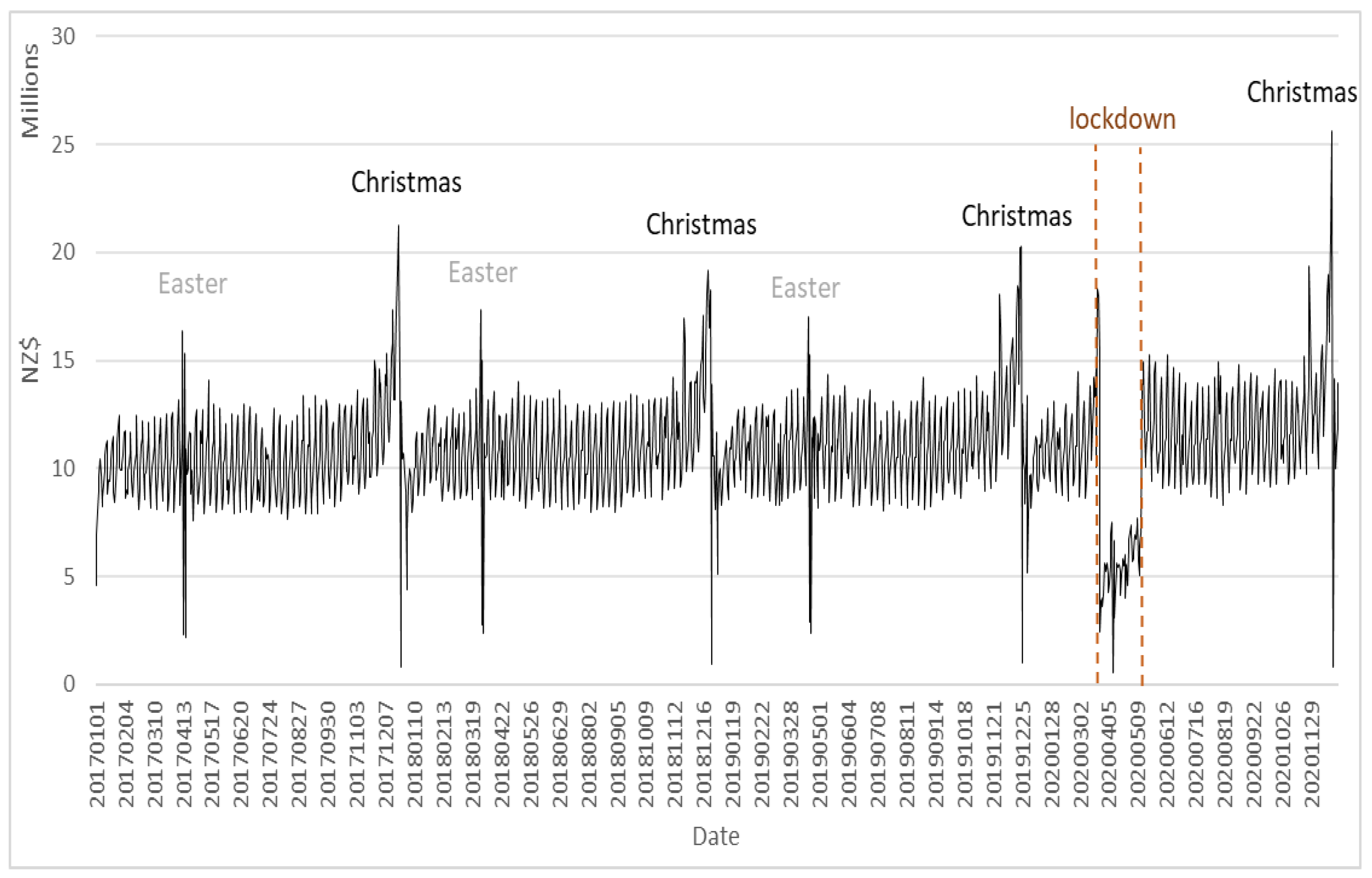
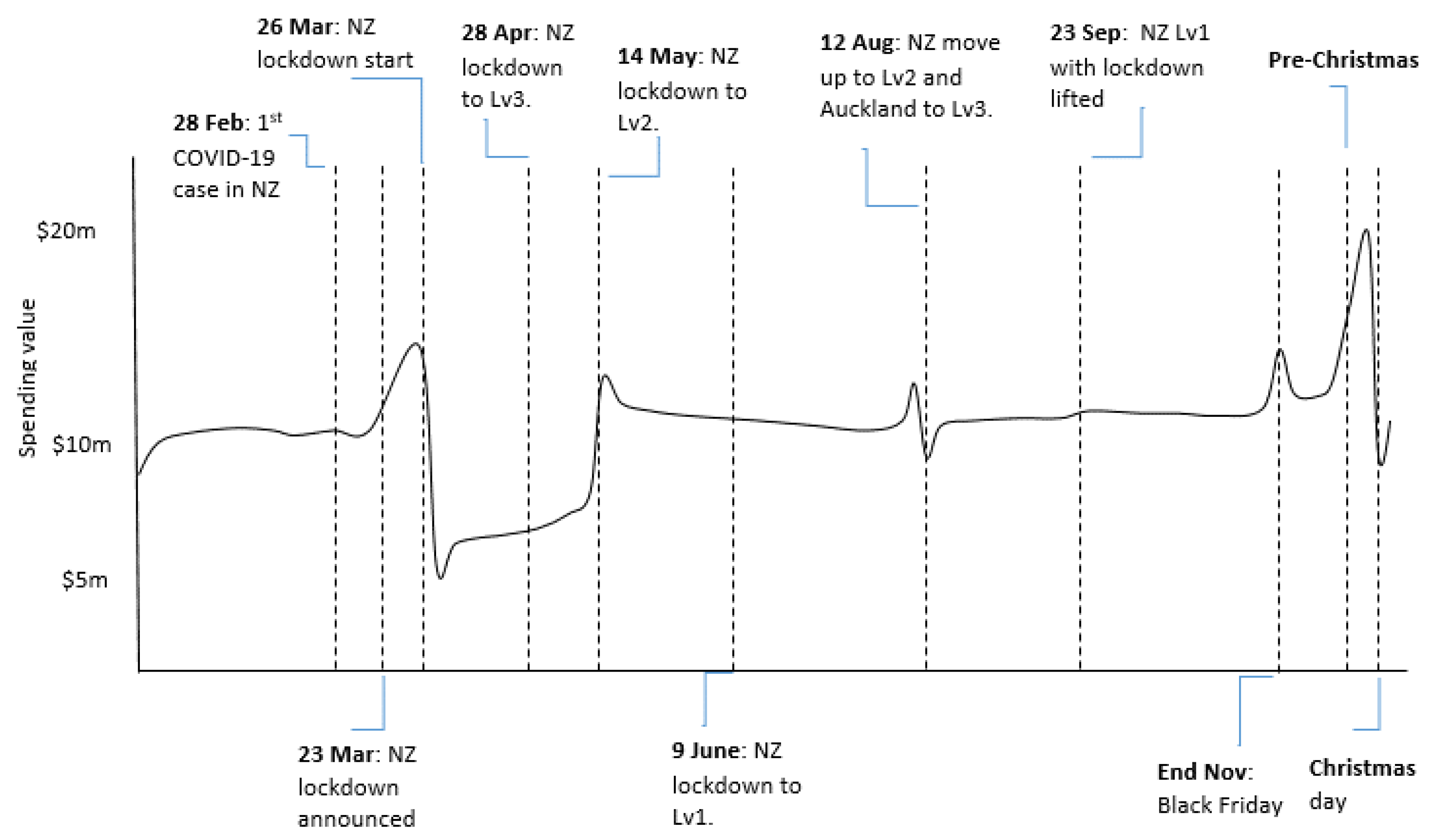
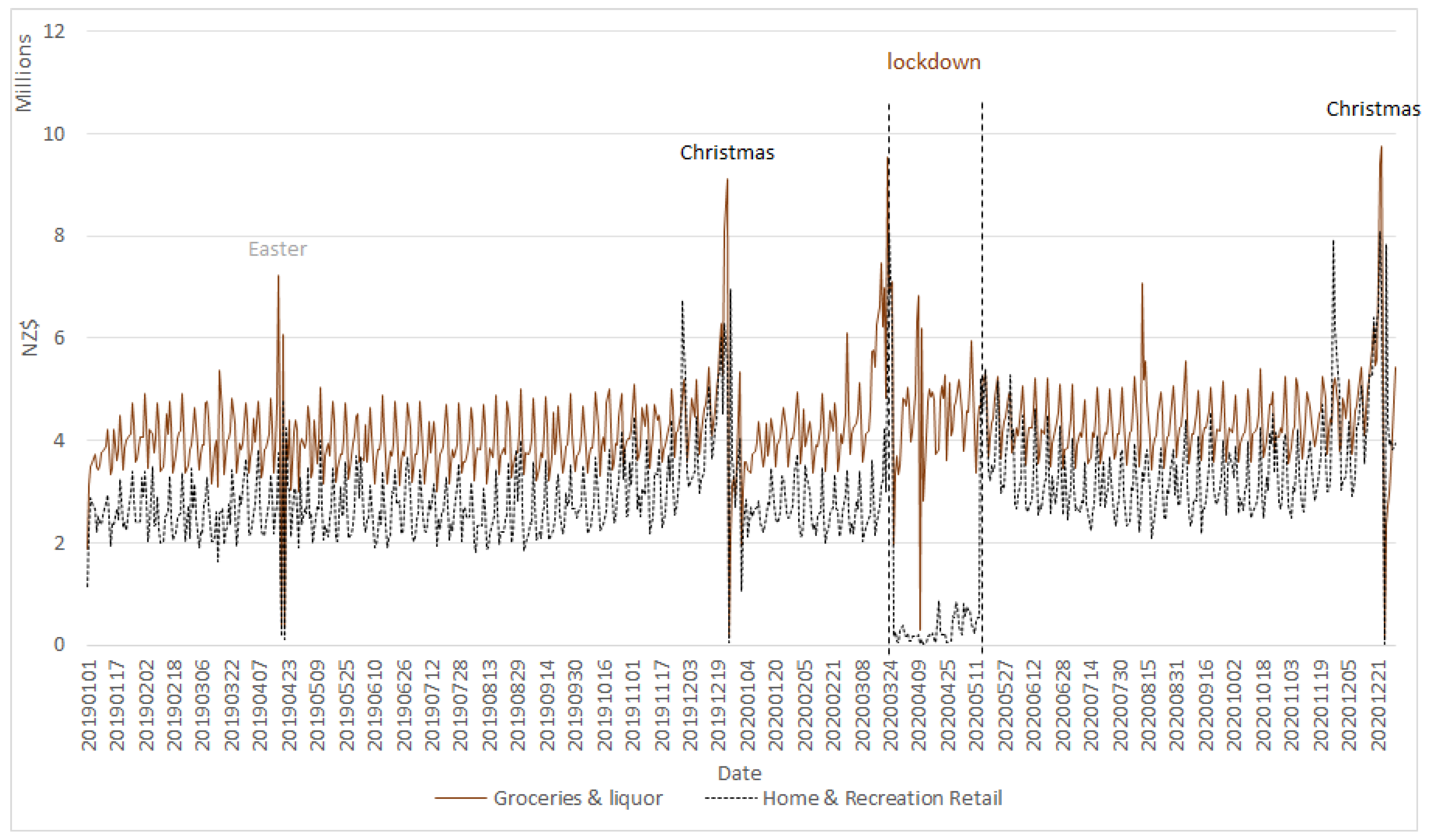
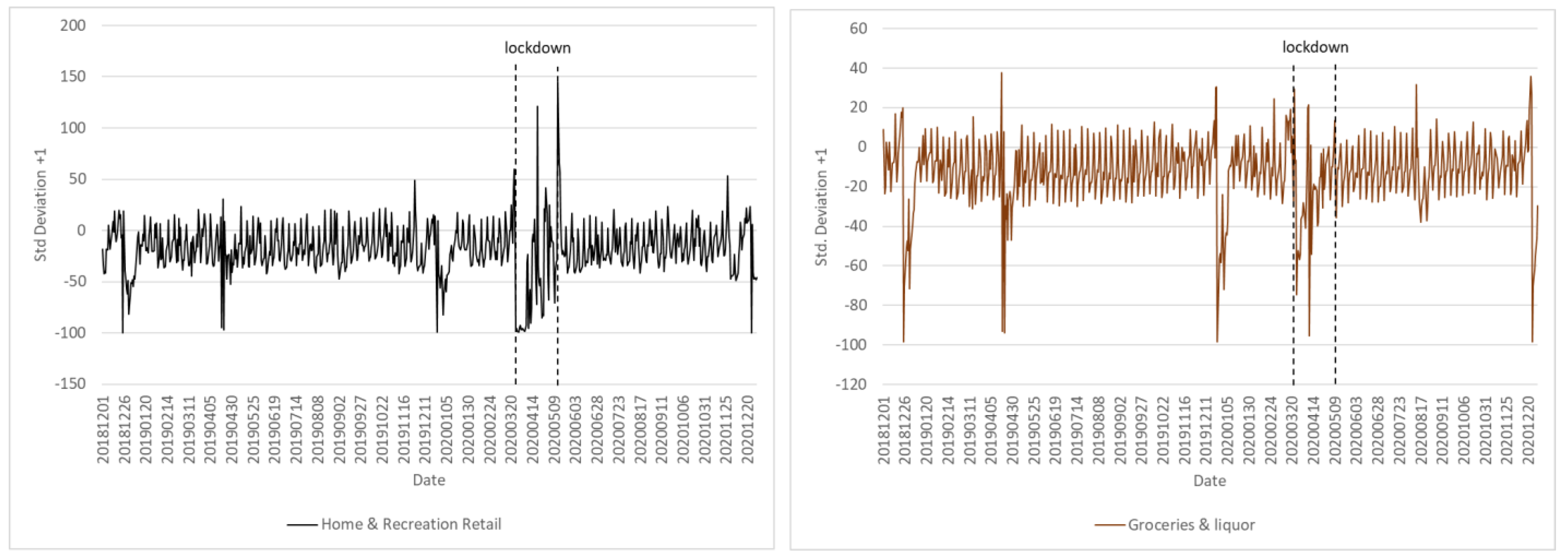
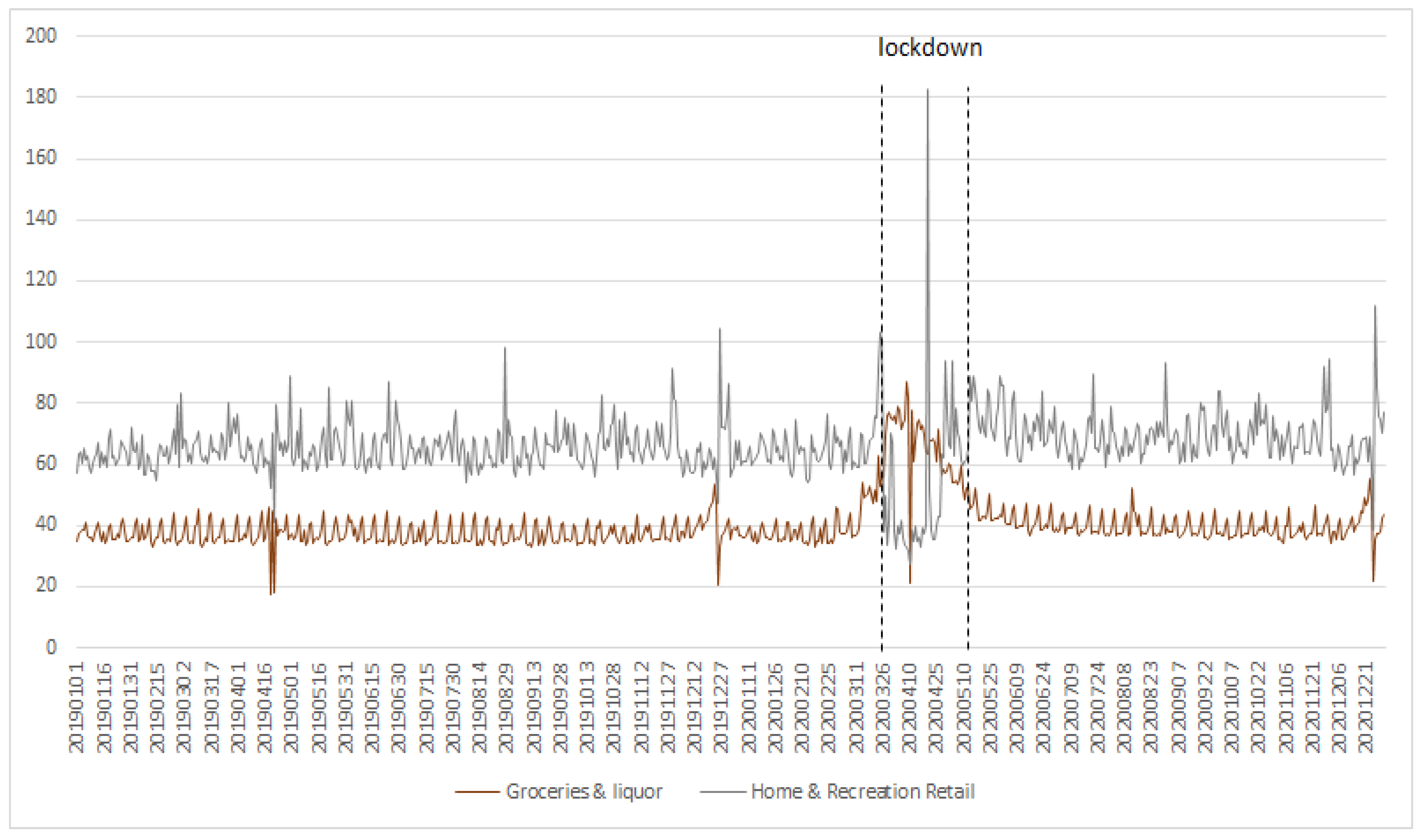
| Alert Level | Risk Assessment | Measures Applied That Affect Consumption |
|---|---|---|
| Alert Level 1 Prepare Disease contained | Isolated household transmission could be occurring in New Zealand | Border entry measures to minimize risk of importing COVID-19 cases Self-isolation and quarantine required if sick Schools and workplaces open Physical distancing encouraged No restrictions on gatherings No restrictions on domestic transport |
| Alert Level 2 Reduce Disease is contained, but risk of community transmission remains | Household transmission could be occurring Single or isolated cluster outbreaks | People can be with friends and family, go shopping, or travel domestically, but should follow public health guidance Physical distancing of two meters, with one meter physical distancing in controlled environments like workplaces unless other measures are in place No more than 100 people at indoor or outdoor gatherings Sport and recreation activities are allowed subject to conditions, contact tracing and physical distancing Public venues must comply with public health measures Businesses open to the public, but must follow public health guidance including in relation to physical distancing and contact tracing Alternative ways of working encouraged Educational facilities open |
| Alert Level 3 Restrict High risk the disease is not contained | Community transmission might be happening New clusters may emerge but can be controlled through testing and contact tracing | People instructed to stay home in their bubble other than for essential personal movement Physical distancing of two meters outside home including on public transport, or one meter in controlled environments like schools and workplaces Bubbles must stay within their immediate household bubble, but can expand to connect with close family, bring in caregivers, or support isolated people. This extended bubble should remain exclusive People must work from home unless that is not possible Businesses can open premises, but cannot physically interact with customers Low-risk local recreation activities are allowed Public venues are closed (libraries, museums, cinemas, food courts, gyms, pools, playgrounds, markets) Gatherings of up to ten people are only allowed for weddings and funerals Inter-regional travel is highly limited to essential workers, with limited exemptions |
| Alert Level 4 Lockdown Likely that disease is not contained | Community transmission is occurring Widespread outbreaks and new clusters | People instructed to stay at home in their bubble other than for essential personal movement Safe recreational activity is allowed in the local area Travel is severely limited All gatherings cancelled and all public venues closed Businesses closed except for essential services, e.g., supermarkets, pharmacies, clinics, petrol stations and lifeline utilities Educational facilities closed Rationing of supplies and requisitioning of facilities possible |
Publisher’s Note: MDPI stays neutral with regard to jurisdictional claims in published maps and institutional affiliations. |
© 2021 by the authors. Licensee MDPI, Basel, Switzerland. This article is an open access article distributed under the terms and conditions of the Creative Commons Attribution (CC BY) license (https://creativecommons.org/licenses/by/4.0/).
Share and Cite
Hall, C.M.; Fieger, P.; Prayag, G.; Dyason, D. Panic Buying and Consumption Displacement during COVID-19: Evidence from New Zealand. Economies 2021, 9, 46. https://doi.org/10.3390/economies9020046
Hall CM, Fieger P, Prayag G, Dyason D. Panic Buying and Consumption Displacement during COVID-19: Evidence from New Zealand. Economies. 2021; 9(2):46. https://doi.org/10.3390/economies9020046
Chicago/Turabian StyleHall, C. Michael, Peter Fieger, Girish Prayag, and David Dyason. 2021. "Panic Buying and Consumption Displacement during COVID-19: Evidence from New Zealand" Economies 9, no. 2: 46. https://doi.org/10.3390/economies9020046
APA StyleHall, C. M., Fieger, P., Prayag, G., & Dyason, D. (2021). Panic Buying and Consumption Displacement during COVID-19: Evidence from New Zealand. Economies, 9(2), 46. https://doi.org/10.3390/economies9020046







